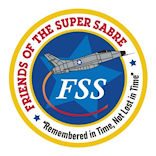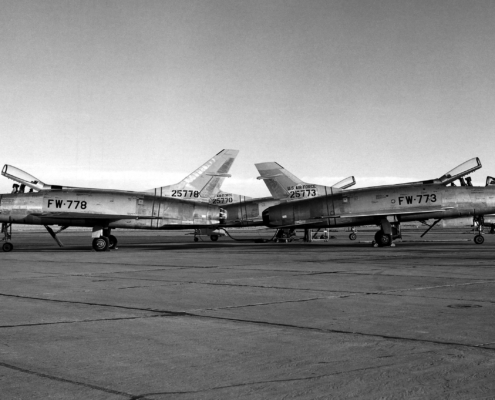The F-100A had been rushed into service with apparent haste, often over the objections of Air Force flight crews who found that the Super Sabre had some serious problems that were not being adequately addressed. Disaster struck on October 12, 1954. On that day, veteran test pilot George Welch was carrying out a maximum performance test dive followed by a high-G pullout with the ninth production F-100A (52-5764) when his aircraft disintegrated in midair. Welch was able to eject, but his injuries proved to be fatal since his airplane had broken at the cockpit area and had sent chunks of metal tearing into his body. On November 8, visiting RAF officer Geoffrey D. Stephenson was killed at Elgin AFB when his F-100A went out of control and crashed. On November 9, Major Frank N. Emory’s F-100A (52-5771) went out of control and crashed during a practice gunnery mission over Nevada. Fortunately, Major Emory was able to eject safely. On November 10, the USAF grounded the entire F-100A fleet, which by this time numbered about seventy aircraft. A further 108 Super Sabres had been completed and were awaiting delivery at the factory.
After an exhaustive investigation, the source of the F-100A’s stability problems was traced to its new shorter tail, which USAF test pilots had suspected all along. A decision was made to switch back to the original taller tail of the YF-100A. 27 percent more vertical tail area was added, which served to delay the onset of instability to speeds above Mach 1.4, which were outside the F-100A’s performance envelope. The aspect ratio of the vertical tail was also increased. With these changes, the height of the modified F-100A increased to 15.34 feet. The wingtip extensions planned for the F-100C were adopted as standard for the F-100A, increasing the wingspan from 36.78 feet to 38.78 feet and the wing area from 376 square feet to 385.21 square feet. The artificial feel systems for the aileron and stabilizer powered controls were modified.
These changes seemed to do the job, and the existing F-100As were retrofitted with the changes. The first aircraft to complete the modification program was the 34th Super Sabre, and the first batch of 11 modified aircraft was delivered to NAA Engineering Flight Test. Because of the rapid rate at which production had been built up, it was not until the 184th airframe that these modifications could be introduced on the assembly line. Earlier aircraft (68 accepted and 112 completed) were retrofitted in hangar areas. Deliveries of the modified F-100A began from the Los Angeles factory in the spring of 1954. The grounding order on the F-100A was finally lifted early in February of 1955.



Recent Comments